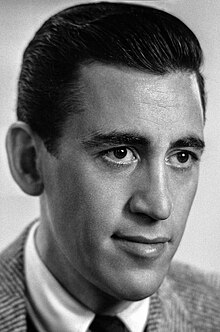Our website is made possible by displaying online advertisements to our visitors.
Please consider supporting us by disabling your ad blocker.
J. D. Salinger
J. D. Salinger | |
|---|---|
 Salinger in 1950 | |
| Born | Jerome David Salinger January 1, 1919 New York City, U.S. |
| Died | January 27, 2010 (aged 91) Cornish, New Hampshire, U.S. |
| Occupation |
|
| Education | |
| Years active | 1940–1965 |
| Notable works | |
| Spouse |
|
| Children | 2, including Matt |
| Signature | |
Jerome David Salinger (/ˈsælɪndʒər/ SAL-in-jər; January 1, 1919 – January 27, 2010) was an American author best known for his 1951 novel The Catcher in the Rye. Salinger published several short stories in Story magazine in 1940, before serving in World War II.[1] In 1948, his critically acclaimed story "A Perfect Day for Bananafish" appeared in The New Yorker, which published much of his later work.[2][3]
The Catcher in the Rye (1951) was an immediate popular success; Salinger's depiction of adolescent alienation and loss of innocence was influential, especially among adolescent readers.[4] The novel was widely read and controversial,[a] and its success led to public attention and scrutiny. Salinger became reclusive, publishing less frequently. He followed Catcher with a short story collection, Nine Stories (1953); Franny and Zooey (1961), a volume containing a novella and a short story; and a volume containing two novellas, Raise High the Roof Beam, Carpenters and Seymour: An Introduction (1963). Salinger's last published work, the novella Hapworth 16, 1924, appeared in The New Yorker on June 19, 1965.
Afterward, Salinger struggled with unwanted attention, including a legal battle in the 1980s with biographer Ian Hamilton and the release in the late 1990s of memoirs written by two people close to him: Joyce Maynard, an ex-lover; and his daughter, Margaret Salinger.
- ^ "J. D. Salinger". EXPLORING Novels. Detroit: Gale, 2003. Web. November 9, 2010.[verification needed]
- ^ "A Perfect Day For Bananafish". The New Yorker. January 24, 1948. Retrieved May 15, 2022.
- ^ "J.D. Salinger". Biography.com. May 4, 2021. Retrieved May 15, 2022.
- ^ Skow, John (September 15, 1961). "Sonny: An Introduction". Time. Archived from the original on October 16, 2007. Retrieved April 12, 2007.
Cite error: There are <ref group=lower-alpha> tags or {{efn}} templates on this page, but the references will not show without a {{reflist|group=lower-alpha}} template or {{notelist}} template (see the help page).
Previous Page Next Page


